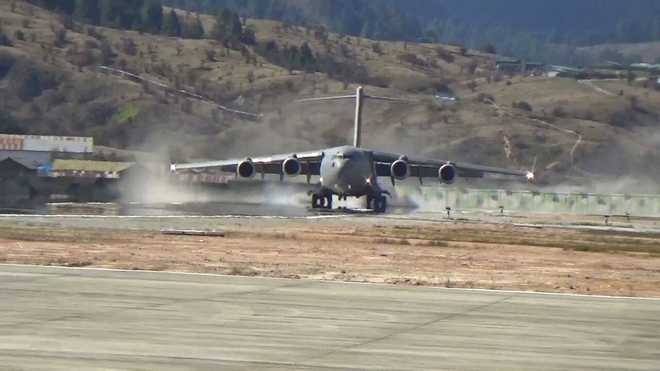
Indian Air Force’s mighty C-17 Globemaster aircraft on Thursday made its first landing at Mechuka, just 29 km from Sino-Indian border in Arunachal Pradesh. ANI
Itanagar/Leh, November 3
Even as Chinese and Indian troops are locked in a stand-off at the icy heights of Ladakh division since Wednesday after People’s Liberation Army personnel stopped the civilian work, Indian Air Force’s mighty C-17 Globemaster aircraft on Thursday made its first landing at Mechuka, just 29 km from Sino-Indian border in Arunachal Pradesh.At an elevation of 6,200 ft with a landing surface only 4,200 ft long, the C-17 landed, validating its short field landing performance at high altitude.(Follow The Tribune on Facebook; and Twitter @thetribunechd)The Advanced Landing Ground at Mechuka in the Yargyap river valley of West Siang district of Arunachal Pradesh had been upgraded recently.Situated along the international border, Mechuka was one of the strategic locations during the India-China war in 1962.The IAF had started its operations with Dakota and Otter in 1962 in the area and subsequently the Antonov-32, popularly known as AN-32, was operated till October 2013 before the upgrade work was started.The road connectivity to the nearest air/rail head at Dibrugarh, about 500 km away, is generally two days of travel, unless the roads get damaged due to frequent landslides.”This is a quantum jump from the existing capability of An-32 and C-130J aircraft. Such airlift capability facilitates speedy transfer of men and material in this rugged terrain, interspersed with valleys and high mountain ranges that inhibit road connectivity,” a statement by the IAF said.In the event of a disaster in the region, C-17 operations to the remote ALG can enhance the speed and quantum of national relief effort.IAF has plans to validate airlift operations to and from various ALGs in the region that would usher in a new dimension in enhanced disaster response.This trial landing is expected to pave the way for operation of civil flights operating to and from the newly upgraded ALGs, which has an enormous potential to boost tourism by improving connectivity to remote locations in the North East.Chinese troops object to civilian workMeanwhile, in Ladakh, the Chinese troops raised objections yesterday when Indian army engineers were constructing an irrigation canal linking ‘hot spring’ waters for the villagers in Demchok, located 250 km east of Leh, under the Mahatma Gandhi National Rural Employment Guarantee Act (MNREGA).Around 55 Chinese troops arrived at the scene and halted the work in an aggressive manner, prompting the army and Indo-Tibetan Border Police (ITBP) personnel to rush to the spot and stop the high-handedness of Chinese troops, official sources said today.The Chinese troops took positions on the perceived Line of Actual Control (LAC) and demanded that work be stopped as either side needs to take permission before undertaking any work, a claim disputed by the Indian side which says that as per the agreement between the two countries, information about construction needs to be shared only if it was meant for defence purposes.Both sides pulled out banners and have been stationed on the ground, the sources said, adding the Army and ITBP was not allowing the Chinese to move an inch ahead despite the PLA claiming that the area belonged to China.The area had witnessed a similar incident in 2014 after it was decided to construct a small irrigation canal at Nilung Nalla under the MNREGA scheme that had been a sore point with the Chinese.The PLA had mobilised villagers from Tashigong to pitch Rebos (tents) at Charding-Ninglung Nallah (CNN) Track Junction to protest Indian action.This time, the sources said, there were 55 personnel from the Chinese PLA whereas nearly 70 personnel from ITBP and army had fortified the area and prevented their march deeper into Indian territory, the sources said.The ‘hot spring’ is different from the one in Chashool where Police Day is observed in memory of 10 CRPF men killed in 1959 by Chinese troops.Meanwhile, senior Army officers insisted that there was no stand-off and the issue is being resolved through established procedures.They added that such objections are not uncommon from either side and situations like these are resolved amicably. — PTI
